|
gm. Słubice, pow. płocki, woj. mazowieckie

The first mention of Świniary dates from the 14th century. The first Dutch homesteads in the village were founded in 1788. Marcin Datzlaw a "German citizen from Sady" undertook to clear the brush. In 1827, the village had 11 houses and 108 residents. In 1890, the village had -23 houses and 183 residents who cultivated 209 morga of land. A 6morga fish stocked lake was situated within the village boundaries The residents grew sugar beets, osier, and fruit and also produced Dutch cheeses.
Świniary is a linear village situated on the southern bank of the Vistula, to the north of Wiączemin Polski and Nowosiadło. It can be reached by an asphalt road from Wymyśl Polski. The road forks in Nowosiadło in the western direction towards Wiączemin Polski and in the eastern direction towards Życk Nowy. The homesteads are located between the asphalt road and the flood-bank on man-made hillocks. The village is divided by the Vistula old riverbed, which was formed after the 1981/82 flood. Majority of the homesteads are situated on the northern side of the village road (in the western and central section of the village). The homesteads in the eastern section of the village can be reached by dirt roads that connect them to the main road. Fragments of the old (19th century) flood-bank have survived. The homesteads are arranged on a shape resembling a square or a rectangle and are surrounded by picket or wattle fences.
The cultural landscape is very well preserved with numerous examples of traditional buildings associated with the Dutch colonization.
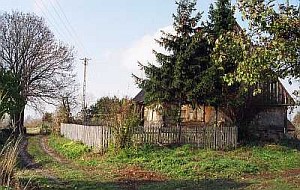 Building no. 9 dates from April 29, 1933 and was erected by Samuel Flemk (inscription on a door frame). It is situated in the central section of the village. Its corner-notched log structure was made of pine, poplar and oak (ground sill) wood with dovetail joints at corners and protruding log ends. High (2.5 m) walls are covered with a high (4.2 m), double-pitched, rafter-collar beam roof, which is reinforced with queen posts, and roofed with roofing paper. A residential section (eastern side) and a cowshed are located under one roof. The residential interior has a two-bay and three-axial layout with an asymmetrically located chimney and a rebuilt brick fire system. The building has a single-room cowshed with a sectioned-off chamber - not in use. The building is in good condition (BK - Jerzy Szałygin, 1996). Building no. 9 dates from April 29, 1933 and was erected by Samuel Flemk (inscription on a door frame). It is situated in the central section of the village. Its corner-notched log structure was made of pine, poplar and oak (ground sill) wood with dovetail joints at corners and protruding log ends. High (2.5 m) walls are covered with a high (4.2 m), double-pitched, rafter-collar beam roof, which is reinforced with queen posts, and roofed with roofing paper. A residential section (eastern side) and a cowshed are located under one roof. The residential interior has a two-bay and three-axial layout with an asymmetrically located chimney and a rebuilt brick fire system. The building has a single-room cowshed with a sectioned-off chamber - not in use. The building is in good condition (BK - Jerzy Szałygin, 1996).
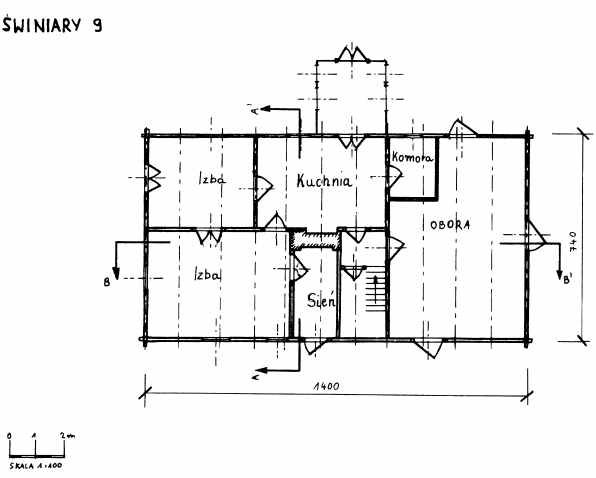
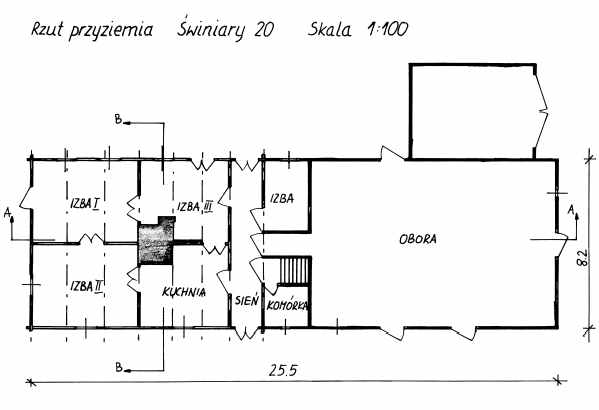 Building no. 20 was erected in 1935 and is located in the western section of the village. It has a solid-tenon-post structure made of pine and poplar (ground sill) wood with dovetail joints at corners and log ends. High (2.8 m) walls are covered with a high (5 m), double-pitched, rafter-collar beam (two pairs of collar beams), which is reinforced with ties and roofed with fiberboard. The ceiling joists in the cowshed rest on a summer beam. The residential section (eastern side) and a cowshed are located under one roof. A shed has been added to the southern side of the cowshed. The residential section has a two-bay and four-axial layout with a centrally located chimney and a brick and tile fire system, which includes a tile kitchen with a cover, a bread oven in the kitchen, a brick heater, and a smokebox in the chimney. The single-space cowshed has a centrally located passageway with stalls for farm animals on both sides. The building is preserved in good condition (BK - Jerzy Szałygin, 1996). Building no. 20 was erected in 1935 and is located in the western section of the village. It has a solid-tenon-post structure made of pine and poplar (ground sill) wood with dovetail joints at corners and log ends. High (2.8 m) walls are covered with a high (5 m), double-pitched, rafter-collar beam (two pairs of collar beams), which is reinforced with ties and roofed with fiberboard. The ceiling joists in the cowshed rest on a summer beam. The residential section (eastern side) and a cowshed are located under one roof. A shed has been added to the southern side of the cowshed. The residential section has a two-bay and four-axial layout with a centrally located chimney and a brick and tile fire system, which includes a tile kitchen with a cover, a bread oven in the kitchen, a brick heater, and a smokebox in the chimney. The single-space cowshed has a centrally located passageway with stalls for farm animals on both sides. The building is preserved in good condition (BK - Jerzy Szałygin, 1996).
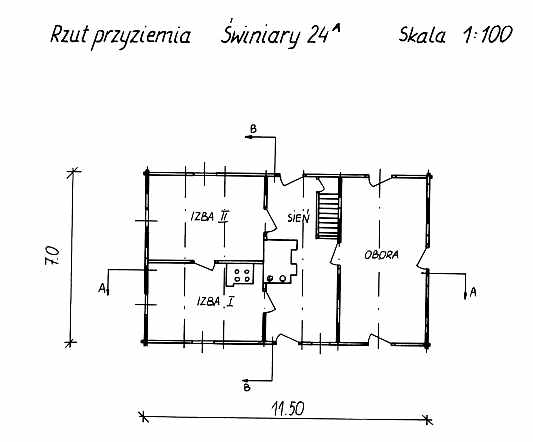 Building no. 24a is a wooden house dating from ca. 1900. It is located in the eastern section of the village on the northern side of the old flood-bank. It is part of a two-building homestead (a barn on the eastern side) and has a solid beam and post structure made of pine and poplar (ground sill) wood with dovetail joints at corners and log ends. Low (2 m) walls are covered with a low (2.7 m) rafter-collar beam, double-pitched roof which is reinforced with queen posts and rests on a pointing sill - asbestos tile roofing. A residential section (eastern side) and a cowshed are located under one roof. The residential section has a one and a half-bay, two-axial layout with a centrally located chimney in the hallway and a brick and tile fire system, which includes two tile kitchens (with a cover) located in the hallway and the room, and a smokebox in the chimney. The cowshed has a single room. The building is preserved in good condition (BK - Jerzy Szałygin, 1996). Building no. 24a is a wooden house dating from ca. 1900. It is located in the eastern section of the village on the northern side of the old flood-bank. It is part of a two-building homestead (a barn on the eastern side) and has a solid beam and post structure made of pine and poplar (ground sill) wood with dovetail joints at corners and log ends. Low (2 m) walls are covered with a low (2.7 m) rafter-collar beam, double-pitched roof which is reinforced with queen posts and rests on a pointing sill - asbestos tile roofing. A residential section (eastern side) and a cowshed are located under one roof. The residential section has a one and a half-bay, two-axial layout with a centrally located chimney in the hallway and a brick and tile fire system, which includes two tile kitchens (with a cover) located in the hallway and the room, and a smokebox in the chimney. The cowshed has a single room. The building is preserved in good condition (BK - Jerzy Szałygin, 1996).
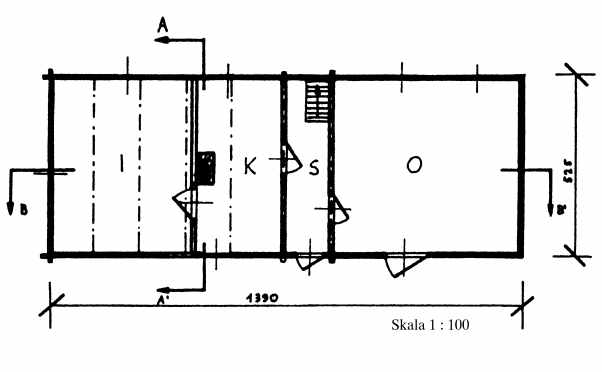 Building no. 26 is a wood-masonry house erected in 1937. It is located in the eastern section of the village on the northern side of the old flood-bank. It is part of a three-building homestead (a barn and a shed on the eastern western sides respectively) and has a corner-notched log structure made of poplar and oak (ground sill) wood with dovetail joints at corners and log ends (residential section). The cowshed is built of hollow brick. Low (2.2 m) walls are covered with a medium (3.3 m) rafter-collar beam, double-pitched roof, which is reinforced with ties and roofed with rye straw (residential section) and fiberboard (cowshed). The residential section (eastern side) and the cowshed are located under one roof. The building has a single-bay and four-axial layout with a narrow chimney located in the kitchen and a metal stove with a kitchen top. The building is preserved in satisfactory condition (BK - Jerzy Szałygin, 1996). Building no. 26 is a wood-masonry house erected in 1937. It is located in the eastern section of the village on the northern side of the old flood-bank. It is part of a three-building homestead (a barn and a shed on the eastern western sides respectively) and has a corner-notched log structure made of poplar and oak (ground sill) wood with dovetail joints at corners and log ends (residential section). The cowshed is built of hollow brick. Low (2.2 m) walls are covered with a medium (3.3 m) rafter-collar beam, double-pitched roof, which is reinforced with ties and roofed with rye straw (residential section) and fiberboard (cowshed). The residential section (eastern side) and the cowshed are located under one roof. The building has a single-bay and four-axial layout with a narrow chimney located in the kitchen and a metal stove with a kitchen top. The building is preserved in satisfactory condition (BK - Jerzy Szałygin, 1996).
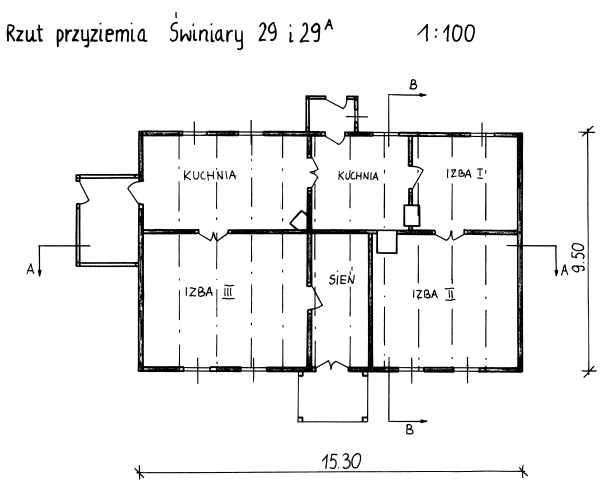 Building no. 29/29a is a masonry house dating from 1938. It is located in the central section of the village on the eastern side of the dirt road that runs from the main road to the flood-bank. The building is part of a four-building homestead with barns from the eastern and northern sides and a cowshed from the southern side. The homestead is surrounded by a wire net and picket fence. Originally, the building also included a farm section (cowshed) under one roof. This section was taken down after WWII. The building is made of bricks bonded with cement-lime mortar - plastered. High (3.7 m) walls are covered with a high (4.2 m) jerkin head, double-pitched, rafter-collar beam roof. It is reinforced with queen posts, and roofed with sheet metal. Three porches have been added to the building walls on three sides (the western one has been decorated with carved elements). The building has a two-bay and three-axial layout with a pants chimney located in the kitchen and room II, which includes tile stoves and kitchen stoves. The building is preserved in very good condition. Building no. 29/29a is a masonry house dating from 1938. It is located in the central section of the village on the eastern side of the dirt road that runs from the main road to the flood-bank. The building is part of a four-building homestead with barns from the eastern and northern sides and a cowshed from the southern side. The homestead is surrounded by a wire net and picket fence. Originally, the building also included a farm section (cowshed) under one roof. This section was taken down after WWII. The building is made of bricks bonded with cement-lime mortar - plastered. High (3.7 m) walls are covered with a high (4.2 m) jerkin head, double-pitched, rafter-collar beam roof. It is reinforced with queen posts, and roofed with sheet metal. Three porches have been added to the building walls on three sides (the western one has been decorated with carved elements). The building has a two-bay and three-axial layout with a pants chimney located in the kitchen and room II, which includes tile stoves and kitchen stoves. The building is preserved in very good condition.
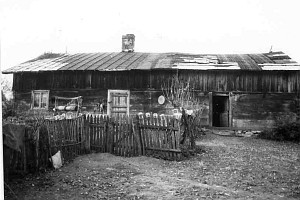 Building no. 33 is a wooden house erected in 1927. It is located in the northern section of the village next to the old flood-bank. It is part of a three-building homestead (a barn and a summer kitchen on the northern side; a well is located between them) with a cellar next located by the south-eastern corner of the building. It has a corner-notched log structure made of poplar and oak (ground sill) wood with dovetail joints at corners and log ends. Short (2.2 m) walls are covered with a low (2.8 m) rafter-collar beam, double-pitched roof which is reinforced with queen posts and rests on pointing sills with sheet metal and roofing paper. A residential section (southern side) and a cowshed are located under one roof. The residential section has a two-bay and two and a half-axial layout with a chimney located centrally between two kitchens, and a brick and tile fire system, which includes two tile kitchen stoves (with a cover) two tile stoves in rooms, as well as a bread oven and a smokebox in the chimney. The building has a single-room cowshed with a summer beam, which supports the rafters. The building is preserved in good condition.
Building no. 33 is a wooden house erected in 1927. It is located in the northern section of the village next to the old flood-bank. It is part of a three-building homestead (a barn and a summer kitchen on the northern side; a well is located between them) with a cellar next located by the south-eastern corner of the building. It has a corner-notched log structure made of poplar and oak (ground sill) wood with dovetail joints at corners and log ends. Short (2.2 m) walls are covered with a low (2.8 m) rafter-collar beam, double-pitched roof which is reinforced with queen posts and rests on pointing sills with sheet metal and roofing paper. A residential section (southern side) and a cowshed are located under one roof. The residential section has a two-bay and two and a half-axial layout with a chimney located centrally between two kitchens, and a brick and tile fire system, which includes two tile kitchen stoves (with a cover) two tile stoves in rooms, as well as a bread oven and a smokebox in the chimney. The building has a single-room cowshed with a summer beam, which supports the rafters. The building is preserved in good condition.
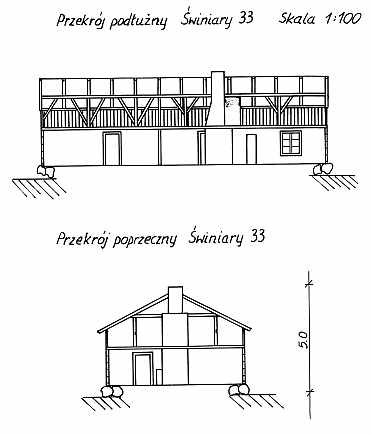 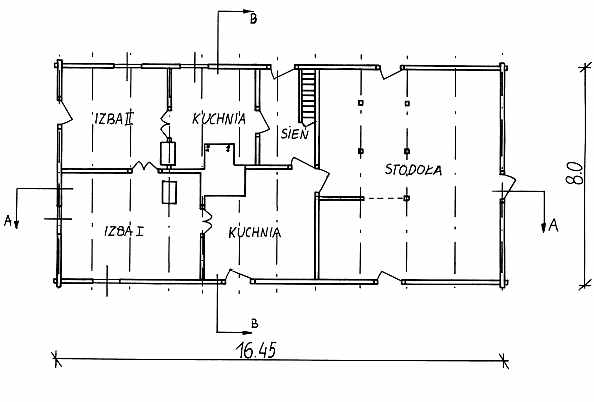
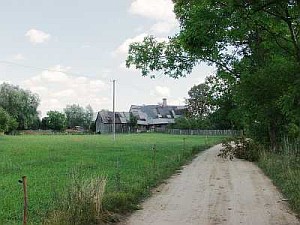 Building no. 36 is a wooden house dating from 1936. It is located in the western section of the village near the road to Wiączemin Polski (on its northern side) along a north-south line. It is part of a two-building homestead (with a cubby-hole and a cellar on the southern side), which is surrounded by a wire net fence. It has two types of structure: a corner-notched log structure made of pine wood with dovetail halvings and protruding log ends and a timber frame structure reinforced with angle braces and struts and boarded with vertical boards (barn). High (2.9 m) walls are covered with a high (4.12 m - original roof covers the residential section, a more recent, lower roof covers the rest), double-pitched, rafter-collar beam roof, which is reinforced with queen posts (above the residential section), and roofed with fiberboard. A henhouse has been added to the northern gable; it has a pent roof. A residential section, a cowshed, and a barn are located under one roof. The residential section has a two-bay and two-axial layout with a wide centrally located chimney, which includes a brick kitchen stove, located in the kitchen and a bread oven and a smokebox situated in the chimney. The cowshed has a single room and a centrally located passage. The barn has one threshing floor and a storage space and is partitioned with a low wall made of logs. The building is preserved in good condition (BK - Jerzy Szałygin, 1996). Building no. 36 is a wooden house dating from 1936. It is located in the western section of the village near the road to Wiączemin Polski (on its northern side) along a north-south line. It is part of a two-building homestead (with a cubby-hole and a cellar on the southern side), which is surrounded by a wire net fence. It has two types of structure: a corner-notched log structure made of pine wood with dovetail halvings and protruding log ends and a timber frame structure reinforced with angle braces and struts and boarded with vertical boards (barn). High (2.9 m) walls are covered with a high (4.12 m - original roof covers the residential section, a more recent, lower roof covers the rest), double-pitched, rafter-collar beam roof, which is reinforced with queen posts (above the residential section), and roofed with fiberboard. A henhouse has been added to the northern gable; it has a pent roof. A residential section, a cowshed, and a barn are located under one roof. The residential section has a two-bay and two-axial layout with a wide centrally located chimney, which includes a brick kitchen stove, located in the kitchen and a bread oven and a smokebox situated in the chimney. The cowshed has a single room and a centrally located passage. The barn has one threshing floor and a storage space and is partitioned with a low wall made of logs. The building is preserved in good condition (BK - Jerzy Szałygin, 1996).
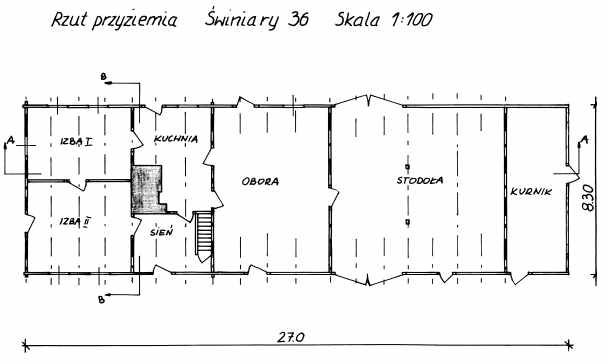
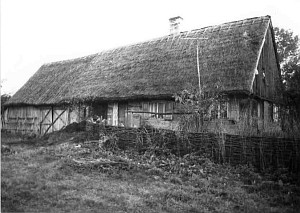 Building no. 37 was made of wood in 1895. It is located in the central section of the village on the northern side of the village road about 50 m from it. It is located along a north-south line in a two-building homestead (a shed and a well on the western side), which is surrounded with a wattle fence. The building was made of pine and has a corner-notched log structure, joined at corners by dovetail halvings with protruding log ends and a timber frame structure (barn and shed), which is reinforced with angle braces and struts and planked with vertical boards. Low (2.2 m) walls are covered with a high (4.50 m), double-pitched, rafter-collar beam roof, which is reinforced with queen posts (above the residential section), and roofed with sheet metal. The ceiling joists in the cowshed rest on a summer beam and on additional crosswise beams. The residential section, the cowshed, and the barn are located under one roof. The residential section has a two-bay and three-axial layout with a wide centrally located chimney, which includes a tile kitchen stove, located in the kitchen, tile stoves in a room and a hallway, and a smokebox situated in the chimney. The cowshed has a single room and a centrally located passage. The barn has one threshing floor and a storage space; two gates are located on the eastern side. The shed also has a door on the eastern side. The building is preserved in a good condition.
Building no. 37 was made of wood in 1895. It is located in the central section of the village on the northern side of the village road about 50 m from it. It is located along a north-south line in a two-building homestead (a shed and a well on the western side), which is surrounded with a wattle fence. The building was made of pine and has a corner-notched log structure, joined at corners by dovetail halvings with protruding log ends and a timber frame structure (barn and shed), which is reinforced with angle braces and struts and planked with vertical boards. Low (2.2 m) walls are covered with a high (4.50 m), double-pitched, rafter-collar beam roof, which is reinforced with queen posts (above the residential section), and roofed with sheet metal. The ceiling joists in the cowshed rest on a summer beam and on additional crosswise beams. The residential section, the cowshed, and the barn are located under one roof. The residential section has a two-bay and three-axial layout with a wide centrally located chimney, which includes a tile kitchen stove, located in the kitchen, tile stoves in a room and a hallway, and a smokebox situated in the chimney. The cowshed has a single room and a centrally located passage. The barn has one threshing floor and a storage space; two gates are located on the eastern side. The shed also has a door on the eastern side. The building is preserved in a good condition.
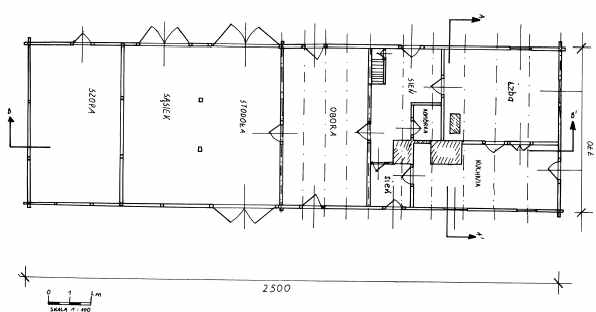
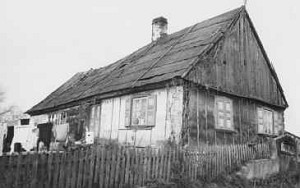 Building no. 42 was made of wood in 1915. It is located in the central section of the village on the southern side of the Vistula's old river bed, approx. 100 m from the road to Wiączemin Polski. It is located along a north-south line in a two-building homestead (a shed on the eastern side and a well on the western side), which is surrounded with a picket fence. The building was made of pine and poplar wood and has a corner-notched log structure connected at corners by dovetail joints with log ends and of bricks (barn and cowshed - plastered from outside). Medium height (2.4) walls are covered with a medium (3.5 m), rafter-collar beam roof, which is reinforced with ties and covered with rye straw and fiberboard. The walls of the residential section are covered with plywood panels (joints covered with slats). The residential section, the cowshed, and the barn are located under one roof. The residential section has a two-bay and two-axial layout with a wide centrally located chimney, which includes a tile kitchen stove with a ventilation hood, located in the kitchen, a tile stove in a room, and a smokebox and a bread oven situated in the chimney. The cowshed has one room and a centrally located passage. The barn has one threshing floor and one storage space. The building is preserved in satisfactory condition. Building no. 42 was made of wood in 1915. It is located in the central section of the village on the southern side of the Vistula's old river bed, approx. 100 m from the road to Wiączemin Polski. It is located along a north-south line in a two-building homestead (a shed on the eastern side and a well on the western side), which is surrounded with a picket fence. The building was made of pine and poplar wood and has a corner-notched log structure connected at corners by dovetail joints with log ends and of bricks (barn and cowshed - plastered from outside). Medium height (2.4) walls are covered with a medium (3.5 m), rafter-collar beam roof, which is reinforced with ties and covered with rye straw and fiberboard. The walls of the residential section are covered with plywood panels (joints covered with slats). The residential section, the cowshed, and the barn are located under one roof. The residential section has a two-bay and two-axial layout with a wide centrally located chimney, which includes a tile kitchen stove with a ventilation hood, located in the kitchen, a tile stove in a room, and a smokebox and a bread oven situated in the chimney. The cowshed has one room and a centrally located passage. The barn has one threshing floor and one storage space. The building is preserved in satisfactory condition.

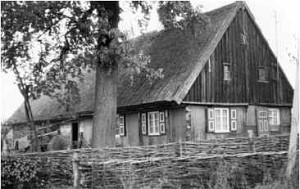 Building no. 43 was made of wood in 1929. It is located in the central section of the village on the northern side of the village along an east-west line. It is a part of a two-building homestead (with a shed and a well located on the northern side), which is surrounded with a wattle fence. The building was made of pine and oak (ground sill) wood; it has a corner-notched log structure, joined at corners by dovetail halvings with protruding log ends and a timber frame structure (barn and shed), which is reinforced with angle braces and struts and planked with vertical boards. Short (1.90 m) walls are covered with a high (4.70 m) rafter-collar beam, double-pitched roof which is reinforced with ties and queen posts and is roofed with rye straw. The walls of the residential section are covered with fiberboard and are stabilized with vertical braces. The residential section, the cowshed, and the barn are located under one roof. The residential section has a two-bay and two-axial layout with a wide centrally located chimney, which includes two tile kitchen stoves, located in the kitchen and in the eastern room, and a tile stove in the western room. A smokebox and a bread oven are situated in the hallway. The cowshed has one room and a centrally located passage. The barn has one threshing floor and a storage space; two gates are located on the southern side. The shed also has a door on the southern side. A henhouse has been added to the northern wall of the building. It has a timber frame structure and is covered with a pent roof. The building is preserved in good condition. Building no. 43 was made of wood in 1929. It is located in the central section of the village on the northern side of the village along an east-west line. It is a part of a two-building homestead (with a shed and a well located on the northern side), which is surrounded with a wattle fence. The building was made of pine and oak (ground sill) wood; it has a corner-notched log structure, joined at corners by dovetail halvings with protruding log ends and a timber frame structure (barn and shed), which is reinforced with angle braces and struts and planked with vertical boards. Short (1.90 m) walls are covered with a high (4.70 m) rafter-collar beam, double-pitched roof which is reinforced with ties and queen posts and is roofed with rye straw. The walls of the residential section are covered with fiberboard and are stabilized with vertical braces. The residential section, the cowshed, and the barn are located under one roof. The residential section has a two-bay and two-axial layout with a wide centrally located chimney, which includes two tile kitchen stoves, located in the kitchen and in the eastern room, and a tile stove in the western room. A smokebox and a bread oven are situated in the hallway. The cowshed has one room and a centrally located passage. The barn has one threshing floor and a storage space; two gates are located on the southern side. The shed also has a door on the southern side. A henhouse has been added to the northern wall of the building. It has a timber frame structure and is covered with a pent roof. The building is preserved in good condition.
.
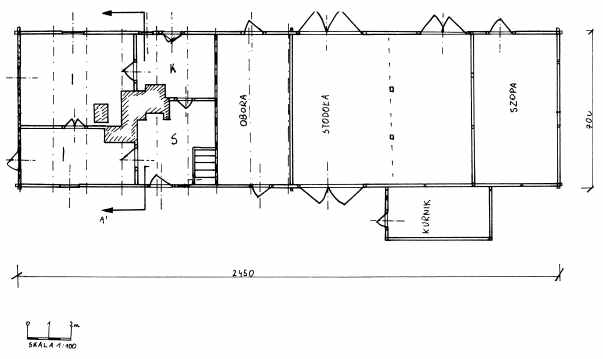
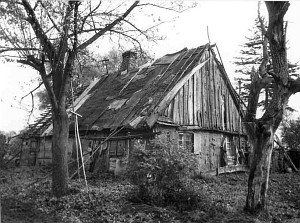 Building no. 45 was made of wood in 1904. It is located in the eastern section of the village on the northern side of the village road about 100 m from it. It is located along a north-south line in a two-building homestead (a henhouse and a well on the eastern side), which is surrounded with a wattle fence. It is entirely built of pine; it has a corner-notched log structure joined at corners by dovetail halvings with protruding log ends. Short (1.90 m) walls are covered with a medium (3.30 m) rafter-collar beam, double-pitched roof which is reinforced with ties (residential section) and is roofed with rye straw and fiberboard. A residential section, a cowshed, and a barn are located under one roof. The residential section has a two-bay and two-axial corner layout with a wide centrally located chimney, which includes a tile kitchen stove with a ventilation hood, located in the hallway and room I, a tile stove in room II, and a smokebox and a bread oven situated in the chimney. The cowshed has one room and a centrally located passage. The barn has one threshing floor and one storage space. The building is in poor condition. Its farm section is almost completely destroyed. Building no. 45 was made of wood in 1904. It is located in the eastern section of the village on the northern side of the village road about 100 m from it. It is located along a north-south line in a two-building homestead (a henhouse and a well on the eastern side), which is surrounded with a wattle fence. It is entirely built of pine; it has a corner-notched log structure joined at corners by dovetail halvings with protruding log ends. Short (1.90 m) walls are covered with a medium (3.30 m) rafter-collar beam, double-pitched roof which is reinforced with ties (residential section) and is roofed with rye straw and fiberboard. A residential section, a cowshed, and a barn are located under one roof. The residential section has a two-bay and two-axial corner layout with a wide centrally located chimney, which includes a tile kitchen stove with a ventilation hood, located in the hallway and room I, a tile stove in room II, and a smokebox and a bread oven situated in the chimney. The cowshed has one room and a centrally located passage. The barn has one threshing floor and one storage space. The building is in poor condition. Its farm section is almost completely destroyed.
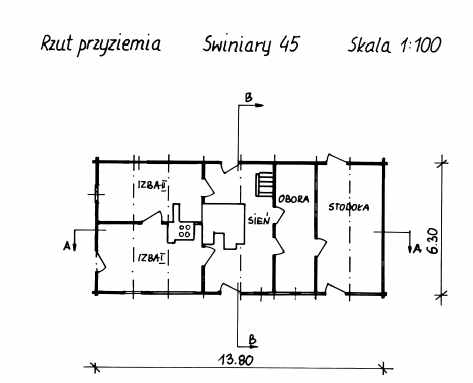
Non-existent houses:
A building without a number was located in the western section of the village. The house was built in 1897 and was part of a three-building homestead, which was the last homestead situated behind the new flood-bank (erected in 1947). It was positioned along a north - south line facing the south with its residential section. The homestead, which included a house, a cowshed and a barn, was taken down in 1997 (BK- Jerzy Szałygin, 1994).
AGAD, Księgi Ziemskie Gostynińsko-Gąbińskie. Księga 4. Recog et Oblatei 1788-1791;
SGKP, t. XI, 1890, s. 704.
|

 Building no. 9 dates from April 29, 1933 and was erected by Samuel Flemk (inscription on a door frame). It is situated in the central section of the village. Its corner-notched log structure was made of pine, poplar and oak (ground sill) wood with dovetail joints at corners and protruding log ends. High (2.5 m) walls are covered with a high (4.2 m), double-pitched, rafter-collar beam roof, which is reinforced with queen posts, and roofed with roofing paper. A residential section (eastern side) and a cowshed are located under one roof. The residential interior has a two-bay and three-axial layout with an asymmetrically located chimney and a rebuilt brick fire system. The building has a single-room cowshed with a sectioned-off chamber - not in use. The building is in good condition (BK - Jerzy Szałygin, 1996).
Building no. 9 dates from April 29, 1933 and was erected by Samuel Flemk (inscription on a door frame). It is situated in the central section of the village. Its corner-notched log structure was made of pine, poplar and oak (ground sill) wood with dovetail joints at corners and protruding log ends. High (2.5 m) walls are covered with a high (4.2 m), double-pitched, rafter-collar beam roof, which is reinforced with queen posts, and roofed with roofing paper. A residential section (eastern side) and a cowshed are located under one roof. The residential interior has a two-bay and three-axial layout with an asymmetrically located chimney and a rebuilt brick fire system. The building has a single-room cowshed with a sectioned-off chamber - not in use. The building is in good condition (BK - Jerzy Szałygin, 1996).




 Building no. 33 is a wooden house erected in 1927. It is located in the northern section of the village next to the old flood-bank. It is part of a three-building homestead (a barn and a summer kitchen on the northern side; a well is located between them) with a cellar next located by the south-eastern corner of the building. It has a corner-notched log structure made of poplar and oak (ground sill) wood with dovetail joints at corners and log ends. Short (2.2 m) walls are covered with a low (2.8 m) rafter-collar beam, double-pitched roof which is reinforced with queen posts and rests on pointing sills with sheet metal and roofing paper. A residential section (southern side) and a cowshed are located under one roof. The residential section has a two-bay and two and a half-axial layout with a chimney located centrally between two kitchens, and a brick and tile fire system, which includes two tile kitchen stoves (with a cover) two tile stoves in rooms, as well as a bread oven and a smokebox in the chimney. The building has a single-room cowshed with a summer beam, which supports the rafters. The building is preserved in good condition.
Building no. 33 is a wooden house erected in 1927. It is located in the northern section of the village next to the old flood-bank. It is part of a three-building homestead (a barn and a summer kitchen on the northern side; a well is located between them) with a cellar next located by the south-eastern corner of the building. It has a corner-notched log structure made of poplar and oak (ground sill) wood with dovetail joints at corners and log ends. Short (2.2 m) walls are covered with a low (2.8 m) rafter-collar beam, double-pitched roof which is reinforced with queen posts and rests on pointing sills with sheet metal and roofing paper. A residential section (southern side) and a cowshed are located under one roof. The residential section has a two-bay and two and a half-axial layout with a chimney located centrally between two kitchens, and a brick and tile fire system, which includes two tile kitchen stoves (with a cover) two tile stoves in rooms, as well as a bread oven and a smokebox in the chimney. The building has a single-room cowshed with a summer beam, which supports the rafters. The building is preserved in good condition.


 Building no. 36 is a wooden house dating from 1936. It is located in the western section of the village near the road to Wiączemin Polski (on its northern side) along a north-south line. It is part of a two-building homestead (with a cubby-hole and a cellar on the southern side), which is surrounded by a wire net fence. It has two types of structure: a corner-notched log structure made of pine wood with dovetail halvings and protruding log ends and a timber frame structure reinforced with angle braces and struts and boarded with vertical boards (barn). High (2.9 m) walls are covered with a high (4.12 m - original roof covers the residential section, a more recent, lower roof covers the rest), double-pitched, rafter-collar beam roof, which is reinforced with queen posts (above the residential section), and roofed with fiberboard. A henhouse has been added to the northern gable; it has a pent roof. A residential section, a cowshed, and a barn are located under one roof. The residential section has a two-bay and two-axial layout with a wide centrally located chimney, which includes a brick kitchen stove, located in the kitchen and a bread oven and a smokebox situated in the chimney. The cowshed has a single room and a centrally located passage. The barn has one threshing floor and a storage space and is partitioned with a low wall made of logs. The building is preserved in good condition (BK - Jerzy Szałygin, 1996).
Building no. 36 is a wooden house dating from 1936. It is located in the western section of the village near the road to Wiączemin Polski (on its northern side) along a north-south line. It is part of a two-building homestead (with a cubby-hole and a cellar on the southern side), which is surrounded by a wire net fence. It has two types of structure: a corner-notched log structure made of pine wood with dovetail halvings and protruding log ends and a timber frame structure reinforced with angle braces and struts and boarded with vertical boards (barn). High (2.9 m) walls are covered with a high (4.12 m - original roof covers the residential section, a more recent, lower roof covers the rest), double-pitched, rafter-collar beam roof, which is reinforced with queen posts (above the residential section), and roofed with fiberboard. A henhouse has been added to the northern gable; it has a pent roof. A residential section, a cowshed, and a barn are located under one roof. The residential section has a two-bay and two-axial layout with a wide centrally located chimney, which includes a brick kitchen stove, located in the kitchen and a bread oven and a smokebox situated in the chimney. The cowshed has a single room and a centrally located passage. The barn has one threshing floor and a storage space and is partitioned with a low wall made of logs. The building is preserved in good condition (BK - Jerzy Szałygin, 1996).
 Building no. 37 was made of wood in 1895. It is located in the central section of the village on the northern side of the village road about 50 m from it. It is located along a north-south line in a two-building homestead (a shed and a well on the western side), which is surrounded with a wattle fence. The building was made of pine and has a corner-notched log structure, joined at corners by dovetail halvings with protruding log ends and a timber frame structure (barn and shed), which is reinforced with angle braces and struts and planked with vertical boards. Low (2.2 m) walls are covered with a high (4.50 m), double-pitched, rafter-collar beam roof, which is reinforced with queen posts (above the residential section), and roofed with sheet metal. The ceiling joists in the cowshed rest on a summer beam and on additional crosswise beams. The residential section, the cowshed, and the barn are located under one roof. The residential section has a two-bay and three-axial layout with a wide centrally located chimney, which includes a tile kitchen stove, located in the kitchen, tile stoves in a room and a hallway, and a smokebox situated in the chimney. The cowshed has a single room and a centrally located passage. The barn has one threshing floor and a storage space; two gates are located on the eastern side. The shed also has a door on the eastern side. The building is preserved in a good condition.
Building no. 37 was made of wood in 1895. It is located in the central section of the village on the northern side of the village road about 50 m from it. It is located along a north-south line in a two-building homestead (a shed and a well on the western side), which is surrounded with a wattle fence. The building was made of pine and has a corner-notched log structure, joined at corners by dovetail halvings with protruding log ends and a timber frame structure (barn and shed), which is reinforced with angle braces and struts and planked with vertical boards. Low (2.2 m) walls are covered with a high (4.50 m), double-pitched, rafter-collar beam roof, which is reinforced with queen posts (above the residential section), and roofed with sheet metal. The ceiling joists in the cowshed rest on a summer beam and on additional crosswise beams. The residential section, the cowshed, and the barn are located under one roof. The residential section has a two-bay and three-axial layout with a wide centrally located chimney, which includes a tile kitchen stove, located in the kitchen, tile stoves in a room and a hallway, and a smokebox situated in the chimney. The cowshed has a single room and a centrally located passage. The barn has one threshing floor and a storage space; two gates are located on the eastern side. The shed also has a door on the eastern side. The building is preserved in a good condition.
 Building no. 42 was made of wood in 1915. It is located in the central section of the village on the southern side of the Vistula's old river bed, approx. 100 m from the road to Wiączemin Polski. It is located along a north-south line in a two-building homestead (a shed on the eastern side and a well on the western side), which is surrounded with a picket fence. The building was made of pine and poplar wood and has a corner-notched log structure connected at corners by dovetail joints with log ends and of bricks (barn and cowshed - plastered from outside). Medium height (2.4) walls are covered with a medium (3.5 m), rafter-collar beam roof, which is reinforced with ties and covered with rye straw and fiberboard. The walls of the residential section are covered with plywood panels (joints covered with slats). The residential section, the cowshed, and the barn are located under one roof. The residential section has a two-bay and two-axial layout with a wide centrally located chimney, which includes a tile kitchen stove with a ventilation hood, located in the kitchen, a tile stove in a room, and a smokebox and a bread oven situated in the chimney. The cowshed has one room and a centrally located passage. The barn has one threshing floor and one storage space. The building is preserved in satisfactory condition.
Building no. 42 was made of wood in 1915. It is located in the central section of the village on the southern side of the Vistula's old river bed, approx. 100 m from the road to Wiączemin Polski. It is located along a north-south line in a two-building homestead (a shed on the eastern side and a well on the western side), which is surrounded with a picket fence. The building was made of pine and poplar wood and has a corner-notched log structure connected at corners by dovetail joints with log ends and of bricks (barn and cowshed - plastered from outside). Medium height (2.4) walls are covered with a medium (3.5 m), rafter-collar beam roof, which is reinforced with ties and covered with rye straw and fiberboard. The walls of the residential section are covered with plywood panels (joints covered with slats). The residential section, the cowshed, and the barn are located under one roof. The residential section has a two-bay and two-axial layout with a wide centrally located chimney, which includes a tile kitchen stove with a ventilation hood, located in the kitchen, a tile stove in a room, and a smokebox and a bread oven situated in the chimney. The cowshed has one room and a centrally located passage. The barn has one threshing floor and one storage space. The building is preserved in satisfactory condition. Building no. 43 was made of wood in 1929. It is located in the central section of the village on the northern side of the village along an east-west line. It is a part of a two-building homestead (with a shed and a well located on the northern side), which is surrounded with a wattle fence. The building was made of pine and oak (ground sill) wood; it has a corner-notched log structure, joined at corners by dovetail halvings with protruding log ends and a timber frame structure (barn and shed), which is reinforced with angle braces and struts and planked with vertical boards. Short (1.90 m) walls are covered with a high (4.70 m) rafter-collar beam, double-pitched roof which is reinforced with ties and queen posts and is roofed with rye straw. The walls of the residential section are covered with fiberboard and are stabilized with vertical braces. The residential section, the cowshed, and the barn are located under one roof. The residential section has a two-bay and two-axial layout with a wide centrally located chimney, which includes two tile kitchen stoves, located in the kitchen and in the eastern room, and a tile stove in the western room. A smokebox and a bread oven are situated in the hallway. The cowshed has one room and a centrally located passage. The barn has one threshing floor and a storage space; two gates are located on the southern side. The shed also has a door on the southern side. A henhouse has been added to the northern wall of the building. It has a timber frame structure and is covered with a pent roof. The building is preserved in good condition.
Building no. 43 was made of wood in 1929. It is located in the central section of the village on the northern side of the village along an east-west line. It is a part of a two-building homestead (with a shed and a well located on the northern side), which is surrounded with a wattle fence. The building was made of pine and oak (ground sill) wood; it has a corner-notched log structure, joined at corners by dovetail halvings with protruding log ends and a timber frame structure (barn and shed), which is reinforced with angle braces and struts and planked with vertical boards. Short (1.90 m) walls are covered with a high (4.70 m) rafter-collar beam, double-pitched roof which is reinforced with ties and queen posts and is roofed with rye straw. The walls of the residential section are covered with fiberboard and are stabilized with vertical braces. The residential section, the cowshed, and the barn are located under one roof. The residential section has a two-bay and two-axial layout with a wide centrally located chimney, which includes two tile kitchen stoves, located in the kitchen and in the eastern room, and a tile stove in the western room. A smokebox and a bread oven are situated in the hallway. The cowshed has one room and a centrally located passage. The barn has one threshing floor and a storage space; two gates are located on the southern side. The shed also has a door on the southern side. A henhouse has been added to the northern wall of the building. It has a timber frame structure and is covered with a pent roof. The building is preserved in good condition.
 Building no. 45 was made of wood in 1904. It is located in the eastern section of the village on the northern side of the village road about 100 m from it. It is located along a north-south line in a two-building homestead (a henhouse and a well on the eastern side), which is surrounded with a wattle fence. It is entirely built of pine; it has a corner-notched log structure joined at corners by dovetail halvings with protruding log ends. Short (1.90 m) walls are covered with a medium (3.30 m) rafter-collar beam, double-pitched roof which is reinforced with ties (residential section) and is roofed with rye straw and fiberboard. A residential section, a cowshed, and a barn are located under one roof. The residential section has a two-bay and two-axial corner layout with a wide centrally located chimney, which includes a tile kitchen stove with a ventilation hood, located in the hallway and room I, a tile stove in room II, and a smokebox and a bread oven situated in the chimney. The cowshed has one room and a centrally located passage. The barn has one threshing floor and one storage space. The building is in poor condition. Its farm section is almost completely destroyed.
Building no. 45 was made of wood in 1904. It is located in the eastern section of the village on the northern side of the village road about 100 m from it. It is located along a north-south line in a two-building homestead (a henhouse and a well on the eastern side), which is surrounded with a wattle fence. It is entirely built of pine; it has a corner-notched log structure joined at corners by dovetail halvings with protruding log ends. Short (1.90 m) walls are covered with a medium (3.30 m) rafter-collar beam, double-pitched roof which is reinforced with ties (residential section) and is roofed with rye straw and fiberboard. A residential section, a cowshed, and a barn are located under one roof. The residential section has a two-bay and two-axial corner layout with a wide centrally located chimney, which includes a tile kitchen stove with a ventilation hood, located in the hallway and room I, a tile stove in room II, and a smokebox and a bread oven situated in the chimney. The cowshed has one room and a centrally located passage. The barn has one threshing floor and one storage space. The building is in poor condition. Its farm section is almost completely destroyed.